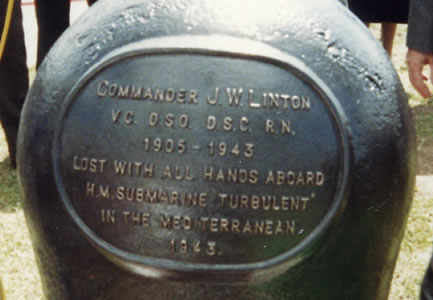Newport's Memorial to Submarine Hero
By Jim Dyer
First published in Sea Breezes, 1987
© Jim Dyer 2012
Gwent's major town and seaport, Newport, has paid tribute to one of its wartime heroes, the late Commander John 'Tubby' Linton, a submarine ace with a string of decorations for bravery. Linton had an outstanding career in the submarine service until he was lost with his vessel. HMS Turbulent in February 1943. His record of tonnage sunk, some 100,000 tons, was the second highest of any British submarine commander during the war.
The event was organised by the recently formed Newport Maritime Trust in conjunction with the Welsh branch of the Submarine Old Comrades Association and took the form of unveiling a memorial on the west bank of the River Usk. Representatives from all over Britain paraded through the town together with two holders of the Victoria Cross from the submarine service.
The memorial is a plaque set into a bollard which was once at the entrance lock to Newport's first docks. The unveiling was carried out by Mr Syd Kay, 85, a former chief petty officer of Turbulent. The holder of the DSM, Mr Kay was in hospital at the time of the submarine’s last patrol when his friends and comrades were lost.

The Dean of Monmouth, Rev. Frank Jenkins, dedicates the memorial.

The memorial to Commander JW Linton VC DSO DSC RN.
Lost with all hands aboard HM Submarine "Turbulent" in the Mediteranean, 1943.
John Linton was born in Newport in 1905 and educated at Osborne College and Dartmouth, passing out in 1922. He joined the Royal Navy as a midshipman in HMS Dauntless in 1923 and was with HMS Royal Oak until 1926. He joined the submarine service in 1927 and although he spent two years in HMS Iron Duke and HMS Westcott, the rest of his service was with submarines. His earlier submarines were Oberon and Oswald and he later commanded HMS Sapper.
When the war broke out in 1939 the dedicated and aggressive Linton was commanding HMS Pandora on the China Station as part of the 4th Submarine Flotilla, but was transferred to the Mediterranean in early 1940. The Pandoragained a number of successes including sinking the Vichy French minelaying sloop Rigault de Genoully, to stop the enemy taking her over.
After five patrols the Pandora joined the 8th Flotilla at Gibraltar in 1940. Linton was awarded the DSC for sinking two Italian ships and rapidly built a reputation as a premier submariner and scourge of the Axis naval forces.
He was promoted to commander in December 1941, and became the one and only commander of the new T Class submarine Turbulent. Spurred by Lipton’s ceaseless determination the Turbulent was soon to inflict great damage on enemy shipping. She joined the 1st Flotilla in Alexandria in February 1942, and Linton began to enhance his already distinguished exploits.
In March of that year he sank six Italian schooners on a single patrol, some 1,800 tons, in the Suda Bay and Gulf of Salonica areas. In September 1942, he was awarded the DSO for courage and skill; in successful patrols and by this time had sunk some 17 vessels including the Italian destroyer Pessagno.
The citation to his VC gives an indication of his courage. 'He sighted a convoy of two merchantmen and two destroyers in mist and moonlight. He worked around ahead of the convoy and dived to attack it as it passed through the moon's rays. On bringing his sights to bear he found himself right ahead of a destroyer. Yet he held his course until the destroyer was almost on top of him and, when his sights came on the convoy, he fired. He sank one merchantman and one destroyer outright and set the other merchantman on fire so that she blew up.'
From October 1942, until the Turbulent's last patrol in February 1943, the deadly Linton sank a number of vessels, on occasions surfacing and attacking with gunfire. Over this period the Turbulent cruised the areas around Benghazi, then Sicily coast and the Cavort Islands with Linton hungry for more hits to add to his list. Axis vessels to go were the motorships Kreta, Benghazi, Marte, Vittorio, Beralado, Pozzuoli,and the tanker Utilatas.
On February 24th 1943, Linton headed out from Algiers on what was to be last patrol, the Turbulent's 10th and Linton's 21st. From the Bay of Naples he skirted the Italian coast, sinking the San Vincerzo Paola on March 1st and then switching to Corsica and Sardinia.
On March 14th the Turbulent was spotted off the Corsican coast and three days later the Italians reported blowing-up a submarine in a minefield off Maddalena, an area which was known to have interested the tenacious Linton. After six days of silence the Turbulent was declared lost.
In his last year Linton had spent 254 days at sea, nearly half submerged. His submarine was hunted 13 times and evaded 250 depth charges. He sank two warships and 27 supply ships and destroyed three enemy trains with his forward gun.
Commander Linton's VC and DSO awards were presented to his widow and eldest son by King George VI in February 1941. While Linton was the force behind the Turbulent he could not have achieved such magnificent successes without a dedicated and loyal crew. DSOs. DSCs ans DSMs were awarded to the Turbukent men. Many too were Mentioned in Despatches for their part in her illustrious career.
Jim Dyer – 8th January 12
NOTE
Published in Sea Breezes in July 1987